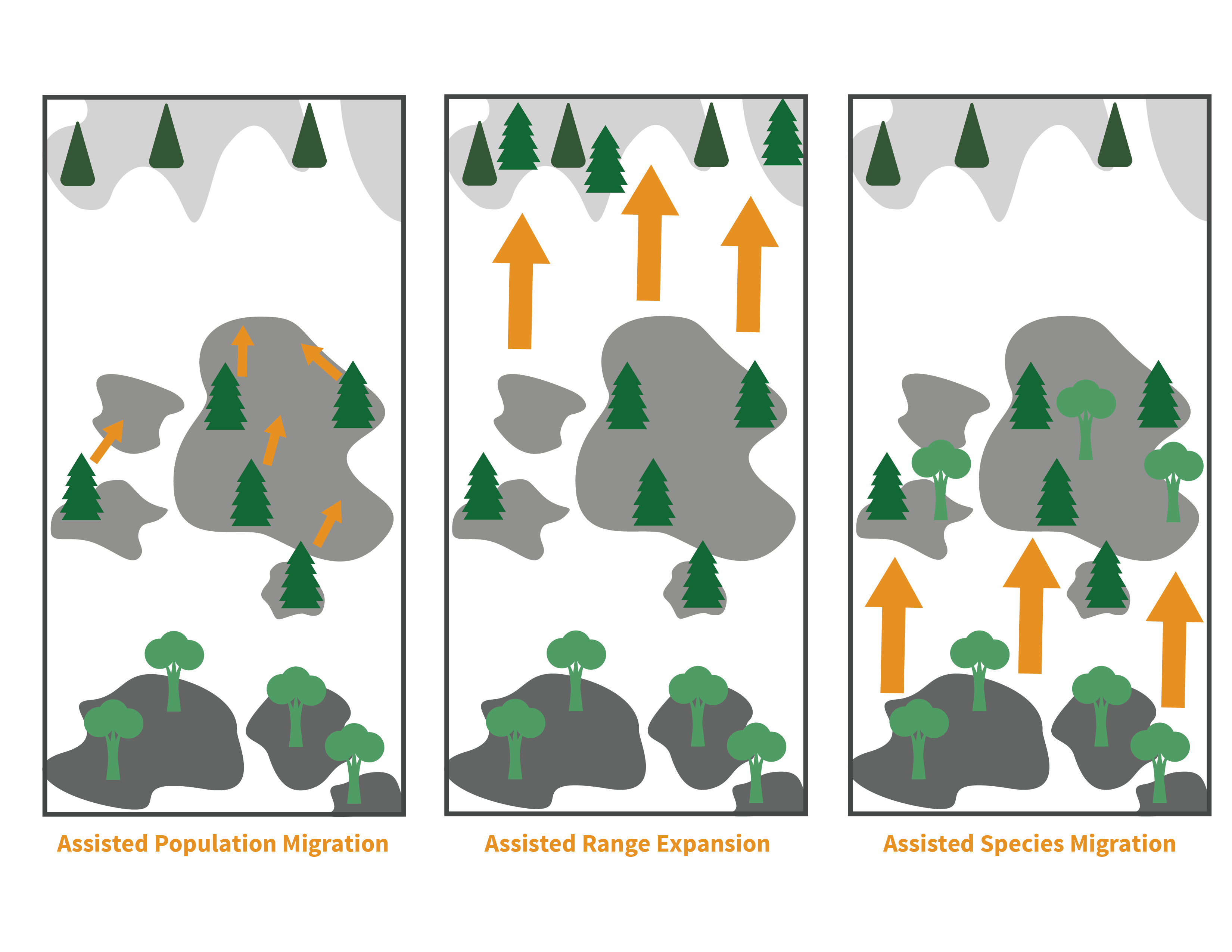Overview
Trees are adapted to specific combinations of environmental and climatic conditions that allow them to grow, thrive, and reproduce. Climate change is already altering conditions across the planet, and changes are expected to continue in the decades to come. The rapid pace of climate change may exceed the ability of many species to adapt in place or migrate to suitable habitats, and this fundamental mismatch raises the possibility of extinction or local extirpation. Assisted migration, human-assisted movement of species in response to climate change, is one management option that is available to address this challenge.
NOTE: This page presents a short summary of content previously presented at the USDA Forest Service Climate Change Resource Center. Download a pdf of the longer article featured on the USDA CCRC that includes an overview that examines research, scientific background and management considerations related to assisted migration, focused primarily on tree species.
Download a pdf of the longer article here.

Scientific Background
Evidence suggests that species have responded individually during historic periods of dramatic climate change through geographic migrations to and from unique glacial refugia. Recent research has demonstrated that many tree species are already undergoing distribution shifts in response to climate change, with different studies highlighting species that are moving poleward and higher in elevation, or moving east-west to track changes in moisture availability.
Many factors can complicate species movement across a fragmented landscape, however, so outcomes of climate change may not follow straightforward expectations. Large-scale FIA studies have revealed that many tree species in the eastern US may be experiencing range contraction at northern and southern range limits. Despite the complexities of forecasting species range shifts into the future, the underlying challenge still remains that many species will face extinction or local extirpation if they do not acclimate, adapt via natural selection, or migrate to new suitable habitats as conditions change. Given the observed and projected rates of change, there is a substantial risk that some species will be unable to migrate quickly enough to track change.
Definitions
Assisted migration, human-assisted movement of species in response to climate change, is a general term that encompasses a variety of different potential actions, which have substantial differences in terms of risk, ecological implications, and policy considerations. Here are some of the commonly used terms that distinguish between different forms of assisted migration:
- Assisted population migration (also assisted genetic migration or assisted gene flow) – moving seed sources or populations to new locations within the historical species range
- Assisted range expansion – moving seed sources or populations from their current range to suitable areas just beyond the historical species range, facilitating or mimicking natural dispersal
- Assisted species migration (also species rescue, managed relocation, or assisted long-distance migration) – moving seed sources or populations to a location far outside the historical species range , beyond locations accessible by natural dispersal
Management Considerations
Assisted migration may be motivated by a variety of different management goals and objectives. Clarifying management intent should be the first step in considering how or if to pursue assisted migration, whether the goal is to maintain or enhance genetic diversity within a population, protect a species or population from extinction, mimic natural dispersal interrupted by human habitat barriers, maintain ecosystem functions, or enhance the productivity of a commercially valuable species. Clearly articulated management goals and objectives will help determine which kinds of assisted migration actions are most suitable (see above definitions) and also help evaluate the benefits and risks.
A land manager may first need to make decisions about which species are appropriate to favor in a given area. Will the current and future climate pose risks to any existing species, and will it be necessary to supplement the existing species composition through assisted migration? Secondly, a manager may need to consider appropriate seedlots or seed sources within populations. There may be populations within a species that are more suited to expected climate conditions, and acquiring seed sources from those populations may help the species perform well into the future. New tools exist to help foresters with both of these decisions, namely the Climate Change Tree Atlas, and ForeCASTS for species-level considerations and the Seedlot Selection Tool for seedlot and seed source considerations.
Assisted migration raises legitimate concerns with respect to economic practicality, ecological suitability, and legal or administrative barriers. In some cases, the concept of assisted migration will directly conflict with established conservation principles (e.g., the precautionary principle) and existing agency policy (e.g. Forest Service seed transfer zones). In some cases, however, it is clear that climate change and other conservation challenges make the risk associated with doing nothing greater than the risk associated with intervening.
NOTE: This page presents a short summary of content previously presented at the USDA Forest Service Climate Change Resource Center. Download a pdf of the longer article featured on the USDA CCRC that includes an overview that examines research, scientific background and management considerations related to assisted migration, focused primarily on tree species.
Download a pdf of the longer article here.
Assisted migration topic page content featured on the CCRC was authored by:
- Stephen Handler, Northern Institute of Applied Climate Science, US Forest Service Northern Research Station, Houghton, MI.
- Carrie Pike, US Forest Service Northeastern Area, West Lafayette, IN.
- Brad St. Clair, US Forest Service Pacific Northwest Research Station, Corvallis, OR.
- Hannah Abbotts, Northern Institute of Applied Climate Science, Michigan Technological University, Houghton, MI.
- Maria Janowiak, Northern Institute of Applied Climate Science, US Forest Service Northern Research Station, Houghton, MI.

